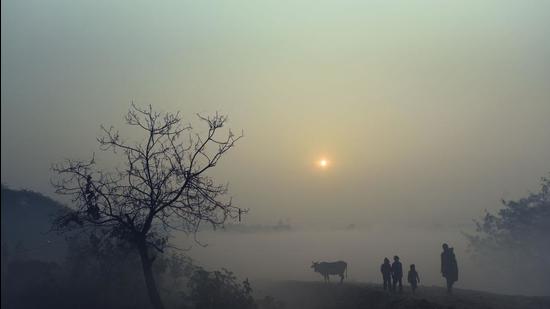2021: The year when Delhi broke a weather record every month
Not only did Delhi see extreme cold waves at the start and end of the year, it witnessed an intense monsoon that continued well into late October as the city recorded 1,512.4mm of rainfall till December 29, the second highest ever
It was a year of extreme weather events and records being broken in the Capital each month this year, which could indicate that the impact of the climate crisis is becoming more prominent over time. Not only did Delhi see extreme cold waves at the start and end of the year, it witnessed an intense monsoon that continued well into late October as the city recorded 1,512.4mm of rainfall till December 29, the second highest ever, behind 1,534.3mm in 1933.

The heat was just as intense, with a “severe heatwave” recorded in June, while Delhi recorded its second warmest February in the last 120 years. March was little different, bringing the hottest day that month in the last 76 years, data from the India Meteorological Department (IMD) shows.
The year began with January recording the highest number of cold wave days (seven) since 2008, and breaking the record for the highest rainfall seen that month in the last 21 years with 56.6mm of precipitation. February on the other hand was a complete contrast, with the cold dissipating to bring uncomfortable heat for that time of the year.
The month recorded a mean maximum temperature of 27.9 degrees Celsius for the entire month, making it the second warmest February in the last 120 years, behind only 2006, when the mean maximum was 29.7 degrees. In March, the maximum touched 40.1 degrees Celsius on March 29, eight degrees above normal for this time of the year.
Then, April brought an unusual cold spell back to the region. Delhi recorded a minimum temperature of 11.7 degrees Celsius (°C) on April 4 – the lowest minimum for the month in 12 years.
In May came the impact of Cyclone Tauktae, and several records tumbled. The cyclone brought 119.3mm of rainfall to Delhi on May 19, the highest single-day rain for the month ever. The same day, Delhi’s maximum temperature was just 23.8°C — the lowest for May since 1951.
The monsoon was erratic, arriving only on July 13 — 16 days after the normal date of June 27. This meant that June sizzled, with a heatwave recorded on June 29, which turned into a “severe heatwave” on June 30, taking Delhi’s maximum to 43.5°C – seven degrees above normal.
From July onwards, several rain records were broken. There were three “heavy rainfall” spells recorded during the month, with the cumulative figure hitting 507.1mm, the second highest ever seen in the city. In August, Delhi recorded a “very heavy” rainfall spell of 138.8mm in a single day – the highest single day rainfall for August since 2007. And in September, Delhi recorded 413.3mm of rainfall – an excess of 230%, making it the highest rainfall for the month since 1944 and the second highest in 121 years.
The monsoon’s exit was delayed by 13 days, finally withdrawing on October 8. However, a “heavy” rainfall spell of 87.9mm on October 18 led to Delhi receiving 122.5mm of rainfall during the month, making it the fourth highest for the month since 1900.
Though no major weather record was broken in November, it was unusual as no western disturbances were recorded for the month, as opposed to usual one to two, making it a polluted month, and one in which the average monthly maximum was 27.8°C, the lowest since 2013.
December so far has been warmer than usual, with the mean minimum temperature hovering at 8.4°C, the highest since 2017, but the Capital saw three “cold wave” days between December 19 and 21, which saw the mercury touching a season-low of 3.2°C. This is Delhi’s lowest for December since 2019.
R.K Jenamani, scientist at the India Meteorological Department, said Delhi has had an unusual year, with frequent western disturbances and wet spells impacting the Capital. “Barring an unusually hot day in March, the period from March to May saw six to eight western disturbances in each month and there were plenty of wet spells. Annually, Delhi has received over 1,500mm of rainfall, but to link it to climate change, one will have to assess data over time,” he said.
Stay updated with all top Cities including, Bengaluru, Delhi, Mumbai and more across India. Stay informed on the latest happenings in World News along with Delhi Election 2025 and Delhi Election Result 2025 Live, New Delhi Election Result Live, Kalkaji Election Result Live at Hindustan Times.
Stay updated with all top Cities including, Bengaluru, Delhi, Mumbai and more across India. Stay informed on the latest happenings in World News along with Delhi Election 2025 and Delhi Election Result 2025 Live, New Delhi Election Result Live, Kalkaji Election Result Live at Hindustan Times.





